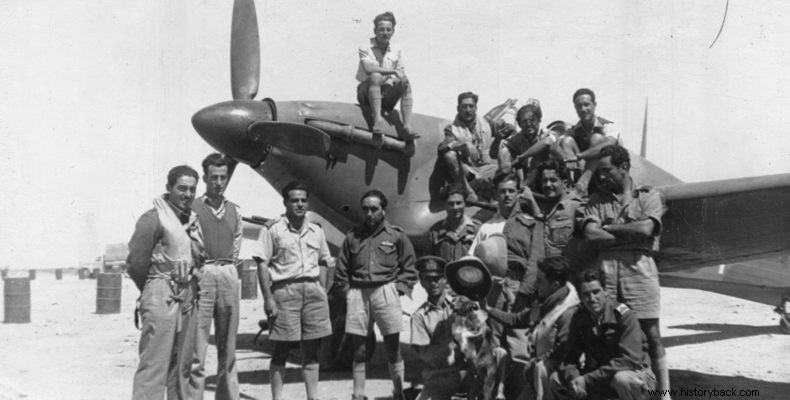
That noon on November 14, 1944, as the first twin-engine Baltimores of the 13th Light Bombardment Squadron appeared over the Attic skies, no one could hide their excitement. After an absence of three and a half years, the Greek Squadrons of the Middle East, which had hunted Rommel in North Africa, sunk German submarines in the Mediterranean, pounded the Nazis in Crete, Italy and the Yugoslav coast, were returning to liberated Athens.
TOU VASILIS PIA
SOURCE:APE-BE
For the pilot of the lead bomber Baltimore, this looked like the end of an odyssey that had begun in April 1941, when he was gradually leaving Greece with the rest of his colleagues, as German planes with Hitler's crosses had destroyed almost the entire of the Greek air force, and the Nazis had occupied the country.
Now huddled behind the glass-enclosed nose of the bomber, he could hardly hold back his tears. He was alive. The twin-engine plane, making a dive over Lycabettus, headed towards Syntagma Square, the propellers rattling in the air, instantly trying to gain height to avoid a chaser, which had just passed seconds before scraping by below.
The sub-commander of the 336th Pursuit Squadron Konstantinos Hatzilakos, son of Athanasios Hatzilakos of Larisa and Eleni Margaritis, could not hide his agitation, as tightly tied to the seat of the Spitfire he narrowly avoided the deadly embrace of the light bomber. Today, at the age of 101, Wing Commander Hatzilakos is the last flying survivor of the "Desert Squadrons" with over two hundred combat missions, and he tells APE-MPE:
"The three Squadrons, (s.s. 13th, 335th and 336th) a total of about seventy planes (Spitfire and Baltimore) started at the same time, one behind the other, crossed the Ionian Sea and via Kefalonia-Patra-Corinth reached from sunny Athens. There we happily began our greeting passages, sometimes in the direction of the Acropolis and sometimes above the University, towards Omonia Square and vice versa towards Syntagma Square. In a few minutes the Athenian sky was filled with individual planes plunging here and there, each over his neighborhood, his father's house, his girl, creating a pandemonium.
I remember I made crossings over the Acropolis sometimes towards Syntagma and sometimes towards Omonia. At one point coming out of a low crossing I found myself dangerously confronted with another Spitfire just above me and in front of two Baltimores, which I passed at high speed scraping under them. We also threw greeting notices that had been printed in Italy".
And the veteran aviator of the Middle East, Wing Commander Constantinos Hatzilakos continues:"The return of November 14, 1944 was not a day of joy for all but only for a few. For most it was medicine. It was a lament. Yes, for most. We the few were the lucky ones, and those who did not return were the most numerous. Of the original 22 operators we manned when 336 Squadron was formed in February 1943, only seven returned. They did not return 15.
Eleven were killed, while another four who had been declared missing during missions against German targets in Crete had been hit by anti-aircraft fire, but were among the lucky ones who were rescued by forced landings and captured. Of the rest of the squadron's operators, another eight were later killed. With this return, a period of competitions of our aviation outside Greece was closed, as a continuation of the competitions in the Epiroti mountains".
Haris Chionidis, the "Yankee" of the 13th Bombardment Squadron
One of the pilots of the 13th Light Bombardment Squadron was Lieutenant Commander Harry Hionides, the son of Greek immigrants from the USA, originally from Pontus, who crossed the border in the summer of 1940, before America even entered the war with Canada, to enlist in the war squadrons of the Commonwealth. "My father wanted to fight for Greece," the journalist's daughter Artemis Chionidou tells APE-MPE. "In June 1940 he left New Jersey for Montreal and was soon in Toronto where he joined the Royal Canadian Air Force.
He was 19 years old. In July 41 he comes to Britain to continue his training as a nautilus, and transfers to the RAF. Via Gibraltar and Malta he arrived in Egypt in May 1942, to join the 13th Greek Bombardment Squadron, (the squadron operated under the operational control of the British Air Force). He took part in the squadron's military missions until December 8, 1943. Many times he spoke about that period of his life to me and my sisters, and as I know to his students at the College of Athens," adds Mrs. Hionidou.
In November 1943 Lieutenant Commander Haris Chionidis as a nautilus of the 13th Squadron will take part in bombing missions against German targets in the port of Souda. In one of these raids after Baltimore had dropped all her bombs on the harbor, she was chased by German planes on her way back to her base. "To escape, the plane entered the Samaria gorge and escaped from there," says Mrs. Chionidou.
On another bombing mission to Spetses, where the Baltimore had previously made a stop at Derna, Egypt for refueling, the plane ran off the runway on takeoff and crashed as the wheels and landing gear broke. "As my father had told me, they ejected because they knew the plane had three bombs that would explode. But they turned back when they saw that the pilot was still in place. They tried to eject him but failed and the pilot was killed when the bombs exploded. This was the last day my father took part in an aviation operation", concludes Mrs. Chionidou.
The Greek flag waves in the desert
When on April 23, 1941, the German Luftwaffe was furiously pounding Greek airfields, five Avro Anson warplanes of the 13th Naval Cooperation Squadron managed to escape via Crete to Dechela, Egypt. These determined airmen do not know that they are the "leaven" for the reconstitution of the Air Force abroad and the creation of Greek combat squadrons within the Royal Air Force (RAF), where they will be subordinate. There, together with war squadrons from Australia, South Africa, New Zealand, France, Poland, they will form the first multicultural force in aviation military history, also known as the "Desert Air Force". Three more training aircraft and a Dornier 22 seaplane will take off from Crete towards freedom.
At the end of April 1941 from the southern coast of Crete and while all of Greece has been occupied by the Germans, the students of the Aviation School of the 10th series of Officers and 6th NCOs on a British ship escape to Egypt and Palestine, together with reserve pilots and machine guns. Out of a total of 800 airmen of various specialties who flocked to the rugged Cretan coast, a large part would be captured by the Germans and later released. For them, their escape to Egypt will continue at their own risk and with a thousand dangers through Turkey and Syria. Another fifty airmen who were already outside Greece since the beginning of 1941 for training at the Habania air base in Iraq will arrive in Egypt.
In Gaza, Palestine, the first reception center for Greek airmen was created with the commander Panagiotis Vilos, who came from Iraq as the first Senior Air Force Commander in the Middle East. In an airport that was basically a strip of barren land and rudimentary facilities, the Aviation School began its operation, with Commander-in-Chief Xenophon Varvaresso and three Avro training vehicles in flight. The British will soon have two aircraft available. In July 1941 a number of airmen were sent to RAF training centers in what was then Southern Rhodesia and South Africa. Soon, expatriates from Egypt, Palestine, Sudan, Syria, and Cyprus will be added to the reception centers for Greek airmen.
13th Light Bombardment Squadron
With the five escaped Avro Anson aircraft from Greece, in the summer of 1941 the first Greek Middle East Squadron was formed and they were the first Greek aviators to raise the blue and white "flying in foreign skies" on an anti-submarine warfare mission on July 14, 1941. In the Squadron December 1941 Blenheim MK IV aircraft were delivered.
In the second half of 1942 the 13th M/EB operates in purely anti-submarine warfare missions and receives the congratulations of the Commander of the Mediterranean Fleet, while in May 1943 the British rank it among the three best squadrons of the Allies. In September 1943 the squadron was manned by Baltimore light bombers. In November 1943 a total of 14 aircraft of the squadron bombed German bases in Souda and by the end of that year they were operating in the S. Aegean.
In April 1944, the 13th Squadron departed for Italy. There it will operate from Biferno airport in the center of the country against ports and German installations on the Yugoslav coast. The most successful mission was the destruction of Fano Bridge, which the British and Americans had not been able to hit. In total the squadron would hit eight submarines, destroy six railway bridges and four ammunition depots, nine port facilities, three road bridges, fuel depots, seven railway stations, three factories and six concentration camps, with a blood toll of 21 airmen.
335th Pursuit Squadron
The 335th Squadron was the first Greek Pursuit Squadron to be formed in the Middle East on 7 October 1941 at Akir Airfield, Palestine, with 8 Hawker Hurricane aircraft. They will soon be replaced with a newer type of Hurricane. The first commander was Commodore Xenophon Varvaressos, who had shouldered the responsibility of transporting the Greek Icarus of the 10th series to Egypt.
Since February 1942, the Squadron is ready for war and protects convoys, while a few months later it will monitor the port of Alexandria. In October 1942, he will take part in the second battle of El Alamein and will attack, among other things, the Italian headquarters on the anniversary of October 28.
On 23 July 1943, eight fighters of the squadron hit German targets in Crete, two did not return. The journalist Maurikios Lightmer and Vasilios Doukas. In December 1943, the replacement of Hurricanes with Spitfires began. In September 1944, the squadron will leave for the Italian front as the German armies collapse in the interior of Europe. It already has 4,000 aircraft sorties while ten operators have been killed in operations.
336th Pursuit Squadron
After the successful course of the two previous squadrons in North Africa, it was decided to create a third with initially operators seconded from 335 Squadron. Squadron Leader Spyros Diamantopoulos was the first commander of 336 Squadron, which was formed on 25 February 1943 equipped with Hurricane fighters. On July 23, 1943, the Squadron with 9 aircraft took part in a raid on Crete. Two did not return. Second Lieutenant Eleftherios Athanasakis who was killed by a German patrol after the crash of his plane, while Second Lieutenant Sotiris Skandzikas who was also captured after his crash was executed in March-1944 during the "great escape" from the Stalag Luft III camp. In October 1943 336 Squadron will be equipped with the first six Spitfires. A month later, Major Spyros Diamantopoulos will be shot down on a mission in Crete, captured but will survive to return to Greece at the end of the war.
In September 1944 the 336th Squadron moves to Italy, the European theater of operations and together with the 335th will carry out offensive missions against the retreating Germans as far as the Yugoslav coast. On October 12, 1944, the day of the liberation of Athens from the Nazi yoke, squadron leader Epaminondas Kottas will also be killed in an ordered operation and is the last dead aviator in air operations abroad, before all three squadrons returned to Greece and landed in the then Hasani ( s.s. Greek) on November 14, 1944. Today, among the aviators of the "Desert Squadrons", are alive Vice-Flat Commander Konstantinos Hatzilakos and Squadron Leader Engineer George Galanos.
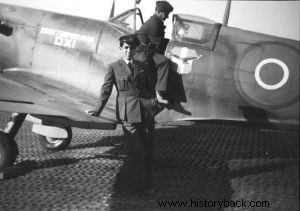
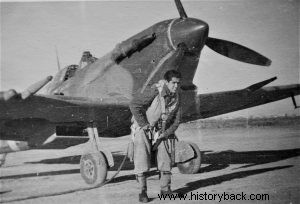
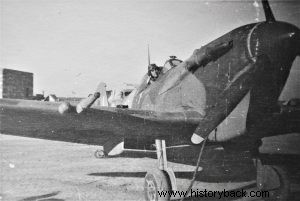
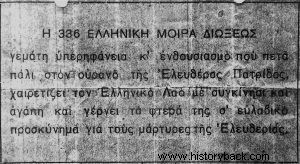
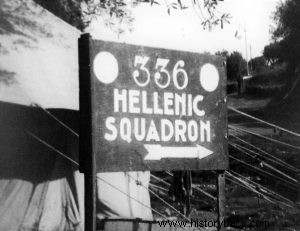
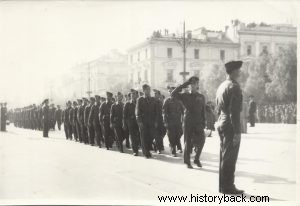
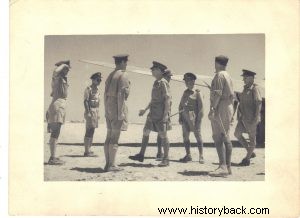
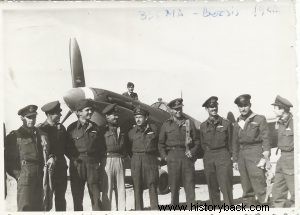
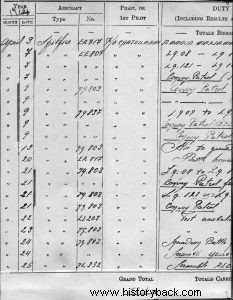
From the individual flight book of the vice-captain e.a. Konstantinou Hatzilakou, where his "Spitfire" missions in April 1944 can be seen.
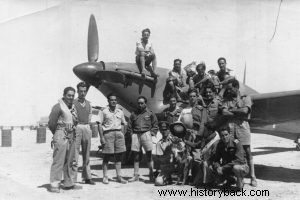
Operators of the 336 Pursuit Squadron, in Sidi Barani, North Africa in 1943. From left, top row:Xanthakos, Stavropoulos, Sarsonis and Tripodis. Standing from left:Skandzikas, Spyromelios, Diamantopoulos (major), Panagopoulos, Nikolopoulos, Spyridonos, Skliris and Kartalamakis. Kneeling from left:Papaioannou, Soufrilas and Hadjilakos. APE BEE/Archive of Constantinos Hatzilakou/STR
